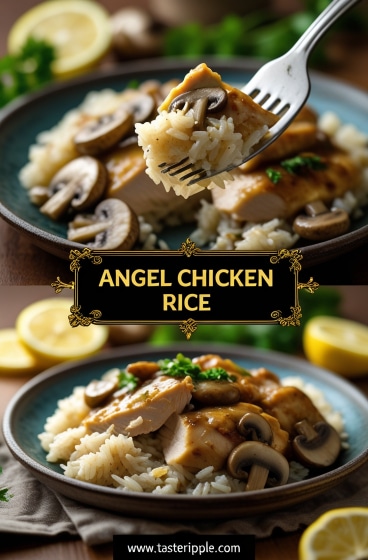I can still remember the first time I tasted Angel Chicken Rice. It wasn’t in some fancy restaurant, not even at a family gathering, but in the back of a church hall where one of the older ladies had brought it in a big glass dish. The smell alone pulled people in. Creamy, rich, almost sweet with onions and wine, clinging to tender chicken like it was made to comfort tired souls. That’s what this dish does. It feeds more than hunger—it soothes.
So what exactly is Angel Chicken Rice? At its core, it’s chicken breasts simmered in a velvety sauce made from cream cheese, white wine, and condensed soup, poured over rice or angel hair pasta. Some versions stick with pasta, others switch to rice for something heartier. Rice soaks that sauce differently—it holds it, it fattens it up, it makes the dish a little sturdier, a little closer to home cooking. That’s why this recipe endures. It’s not complicated, but it carries weight.
Why Angel Chicken Rice is Special
There’s nothing “delicate” about it, despite the angel in its name. Instead, this recipe is about balance. You’ve got the savory punch of garlic and herbs, the mellow sweetness of onions, and the tang of wine cutting through cream. Then the rice comes in—plain, honest, filling—and turns that sauce into a complete meal.
It’s also a dish of adaptability. It welcomes canned soup and boxed broth, but it also shines brighter when you swap in homemade stock or fresh mushrooms sautéed with thyme. The recipe was popularized in American kitchens in the mid-20th century, a time when condensed soup casseroles were queen. But chefs today can refine it without stripping away the heart.
Ingredients and Substitutions
The key to this dish is not just what you use, but how you use it. Chicken breasts work beautifully if you want lean protein, but chicken thighs bring extra richness. Wine lifts the sauce, but broth can stand in if you want it family-friendly. Cream cheese gives body, though mascarpone or even ricotta can play that part with subtle differences.
Here’s the ingredient list for a standard version, with notes on swaps:
Angel Chicken Rice Ingredients
| Ingredient | Measurement | Substitution / Notes |
|---|---|---|
| Boneless, skinless chicken breasts | 4 (about 2 lbs) | Chicken thighs for richer flavor |
| Butter | 4 tbsp | Olive oil for lighter touch |
| Onion, finely chopped | 1 medium | Shallots for sweeter, milder taste |
| Garlic cloves, minced | 3 | Garlic powder if fresh not available |
| Mushrooms, sliced | 8 oz | Omit if disliked, or sub zucchini |
| White wine | ½ cup | Chicken broth for non-alcoholic |
| Condensed cream of chicken soup | 1 can (10.5 oz) | Cream of mushroom or homemade roux |
| Cream cheese, softened | 8 oz | Mascarpone or Greek yogurt |
| Italian seasoning | 1 tsp | Fresh thyme, oregano, basil blend |
| Chicken broth | 1 cup | Vegetable broth |
| Salt | 1 tsp (to taste) | Adjust carefully—soups vary |
| Black pepper | ½ tsp | White pepper for subtle heat |
| Cooked rice | 4 cups | Angel hair pasta for classic style |
| Fresh parsley, chopped | 2 tbsp | Chives or dill for garnish |
Choosing fresh mushrooms over canned changes everything. They brown, they develop that nutty depth, and the sauce grabs onto their juices. Same with onion—yellow onions give backbone, but sweet onions add gentleness. Professionals know: every ingredient is a lever. Pull the right one, and the dish shifts.
Step-by-Step Instructions
Cooking Angel Chicken Rice is not complex, but small choices change results. Here’s the expert path.
Step 1: Prepare the chicken
Season chicken breasts with salt and pepper. Heat butter in a skillet over medium-high until foamy. Sear chicken on both sides until golden, about 3 minutes per side. Don’t crowd the pan—steam ruins sear. Remove and set aside.
Tip: If using thighs, render a bit longer for fat to crisp. Color equals flavor. A pale chicken gives a pale sauce.
Step 2: Build the flavor base
In the same skillet, add onions. Cook until translucent, then add garlic and mushrooms. Stir until mushrooms release moisture and edges caramelize. This step decides the depth of your sauce—rush it, and you lose that savory edge.
Common mistake: Tossing mushrooms in too early with onions on low heat. Mushrooms need real heat to brown, otherwise they stew in their own liquid.
Step 3: Deglaze and simmer
Pour in the wine, scraping up browned bits stuck to the pan. Let it reduce by half. This concentrates the flavor and cooks out harsh alcohol notes. Add condensed soup, cream cheese, Italian seasoning, and broth. Stir until smooth.
Variation: For a spicier dish, slip in crushed red pepper or a spoonful of Dijon mustard. Mustard adds heat without shouting.
Step 4: Return chicken and bake
Nestle seared chicken into a greased baking dish. Pour sauce over. Cover with foil and bake at 350°F for 30–40 minutes until chicken is tender and cooked through.
Expert note: Thin breasts may cook in under 25 minutes. Always check—overcooked chicken loses that juicy bite, and no sauce can fix sawdust texture.
Step 5: Serve over rice
Spoon sauce-soaked chicken onto warm cooked rice. Sprinkle parsley. The rice should be fluffy, hot, ready to drink up the sauce. Cold rice will seize the fat and ruin flow.
Cooking Techniques and Science
Why sear first? Because browning builds the Maillard reaction, producing complex flavors that cream sauces desperately need. Skip it, and the whole dish leans flat.
Why wine? Acidity balances fat. Cream cheese and soup bring weight, but without wine or lemon, it tastes heavy. Professionals often finish with a squeeze of lemon for freshness.
And why rice instead of pasta? Rice absorbs sauce differently. Long-grain rice stays separate, offering bites of both grain and cream. Short-grain rice, like arborio, makes it creamier, almost risotto-like. Professionals might even toast the rice first in butter before cooking—it gives a nutty dimension that plain steamed rice lacks.
Storage and Reheating
Angel Chicken Rice stores well for up to 4 days in the fridge. Always cool it before covering—trapped steam dilutes sauce. Reheat gently on the stove with a splash of broth or milk to loosen the cream. Microwaving works, but stir halfway or you’ll get hot edges and cold centers.
Freezing is tricky. Cream cheese can split after thawing. To freeze, undercook slightly and freeze sauce separately from rice. Reheat sauce slowly, whisking, then serve fresh over hot rice.
Variations
- Vegan version: Swap chicken with seared tofu or mushrooms. Use cashew cream instead of cream cheese, vegetable broth, and vegan condensed soup.
- Gluten-free: Ensure your soup base is gluten-free, or make your own roux with cornstarch. Rice naturally suits gluten-free diets.
- Spicy version: Add cayenne, chili flakes, or even chipotle powder. Cream calms heat, so you can push spice without overpowering.
Tools That Matter
Cast iron or stainless-steel skillets work best for searing. Nonstick won’t give you browned bits. A Dutch oven is excellent if you want to cook everything in one pot. For rice, a heavy-bottomed saucepan or rice cooker ensures consistent texture.
Serving and Pairing Suggestions
Presentation counts. Slice chicken before serving, fanning pieces over rice, and drizzle sauce in a slow ribbon. Garnish with parsley, thyme sprigs, or even fried shallots for crunch.
Pairings? A crisp green salad with lemon vinaigrette cuts richness. Garlic bread makes it indulgent. Wine-wise, a dry Chardonnay mirrors the sauce, while Riesling brings contrast. For non-alcoholic, iced tea with lemon works beautifully.
Best Time to Serve
Angel Chicken Rice isn’t a Tuesday 10-minute dinner. It’s a dish that belongs to weekends, potlucks, cold nights, family gatherings. It feeds a crowd, it reheats well, and it makes people linger at the table. That’s its job.
Conclusion
Angel Chicken Rice is a study in comfort. It’s simple, yes, but behind the simplicity lies technique: searing, balancing acidity with cream, choosing the right rice. Get those right, and you elevate a church-hall casserole into something restaurant worthy.
Key tip: don’t rush the base. That onion-mushroom-garlic step holds the dish together. And always serve hot over fresh rice. Cold rice kills it, every time.
This dish thrives on flexibility. Play with herbs, swap proteins, push spice, or go vegetarian. But keep the soul intact—creamy sauce over warm rice, carrying flavors that remind people of home, even if they’ve never had it before.
FAQs
Q: Can I make Angel Chicken Rice in a slow cooker?
Yes, but sear chicken first for flavor. Cook on low 4–5 hours, then stir in cream cheese near the end. Serve over rice cooked separately.
Q: Can I substitute Greek yogurt for cream cheese?
Yes, but stir it in off-heat. Yogurt curdles if boiled. It gives tang but less body, so consider adding a spoon of cornstarch slurry.
Q: What rice works best?
Long-grain white rice is classic. Jasmine adds fragrance, basmati adds nuttiness. Arborio makes it creamier, but short-grain can verge on too heavy.
Q: Can I use leftover rotisserie chicken?
Absolutely. Shred it and fold into sauce. Just reduce baking time since chicken is already cooked.
Q: How do I make it lighter?
Use reduced-fat cream cheese, replace soup with homemade light broth thickened with cornstarch, and serve over cauliflower rice.

